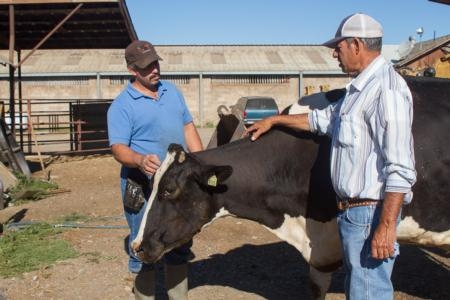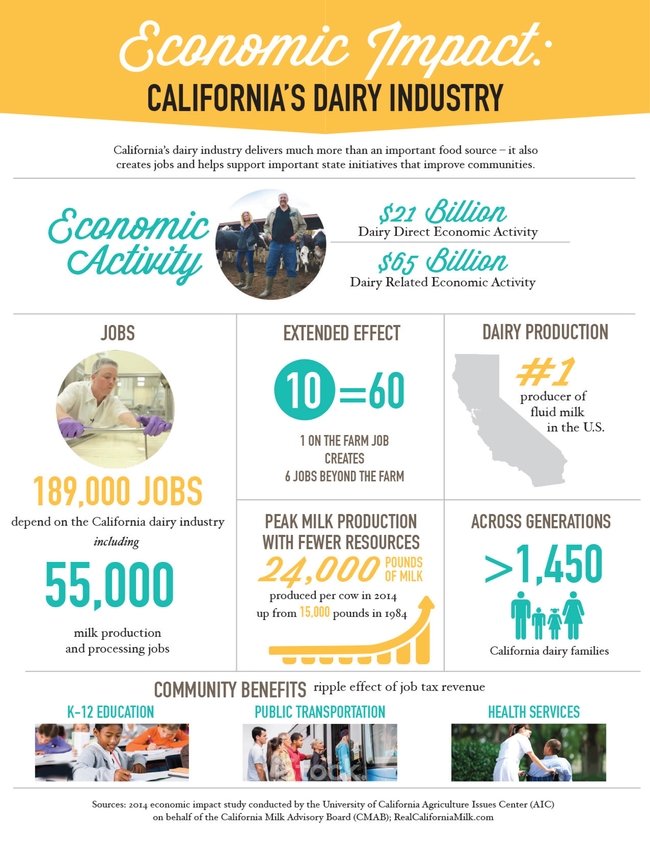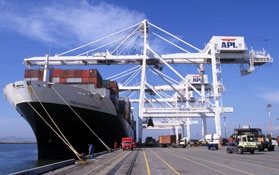Posts Tagged: Daniel Sumner
California dairy industry contributes $21 billion to state’s economy
New study conducted by UC ANR Agricultural Issues Center shows significant impact of state's leading agricultural commodity.
Cementing its place as California's most important agricultural commodity by farm revenue, California farms sold about $9.4 billion worth of milk while the dairy industry contributed approximately $21 billion in value added to the gross state product in 2014, according to a California Milk Advisory Board (CMAB) study conducted by the Agricultural Issues Center, a statewide program of UC Agriculture and Natural Resources. Including sales of inputs to dairy farms and milk processors along with raw milk and wholesale milk product sales, the dairy industry contributed $65 billion in total sales to the California economy in 2014. The growing demand for dairy products like cheese and yogurt as well as strong dairy exports accounted for 189,000 jobs that are dependent on the state's milk production and processing.
“The dairy industry's contributions are vital to California's economy, from creating jobs to stimulating local and regional economies to providing nutritious and enjoyable products to consumers everywhere,” said John Talbot, CEO of the California Milk Advisory Board. “A large number of California residents depend on the dairy industry for employment and these jobs would not exist without it.”
The $21 billion to California's gross state product included $7.4 billion as income to industry workers and owners and $13.4 billion through related, outside industries such as feed, veterinary and accounting services used for dairy production and electricity, packaging, equipment and trucking services used by processors. The tax revenue generated from these jobs supported important statewide initiatives to improve education, healthcare, roads, community services and the environment.
Overall, 189,000 jobs in California are associated with the dairy industry. Of this amount, approximately 30,000 jobs are on the farm and 20,000 jobs represent dairy processing. For every dairy farm job, there are several more jobs that are tied to the business and create a linked chain of economic impacts.
Additionally, the induced effect of the dairy industry also creates jobs in the community to support the area's dairy workers and their families, such as school teachers and local bus drivers.
California Holds Rank as Nation's Dairy Leader
California leads the nation in dairy production and dairy continues as the top commodity in the country's top agricultural state. It has been the nation's largest milk producer since 1993 and is also the country's leading producer of butter, ice cream, nonfat dry milk and whey protein concentrate. California is also the second largest producer of cheese and yogurt.
Farm milk sales generated $9.4 billion gross revenue in 2014. Wholesale dairy product (cheese, fluid milk, ice cream, butter and other dairy) sales hit $25 billion in 2014.
Dairy Farmers Improve Business Performance
As an essential part of California's farming heritage, dairy farmers understand the importance of protecting the land, water and air for their families, their communities and future generations. In 2014, California dairy farmers produced more milk with fewer resources. Talbot credits “improved dairy practices and management adopted by farmers” for the increased business efficiencies. The pounds of milk produced per cow increased to 24,000 pounds in 2014 from 15,000 in 1984. Farmers are applying 23 percent less water to their fields than they did in the early 1980s and have seen their average crop yields increase by more than 40 percent despite using less water.
Beyond the economic impacts calculated in the report, California dairy farmers and employees are active participants in their communities and contribute to social, environmental and other broad public goals.
Study Leaders and Methodology
The study was conducted by a team of researchers at the UC ANR Agricultural Issues Center (AIC). Daniel A. Sumner, the director of AIC who holds the Frank H. Buck, Jr. Chair Professorship in the Department of Agricultural and Resource Economics at UC Davis, led the study. Josué Medellín-Azuara, a project scientist at the UC Davis Center for Watershed Sciences, and Eric Coughlin, a junior research specialist at AIC, were part of the research team. They measured myriad impacts using dairy-specific data for 2012 and projections for 2014 and a database and model of economic linkages (IMPLAN).
About the California Milk Advisory Board
The California Milk Advisory Board (CMAB), an instrumentality of the California Department of Food and Agriculture, is funded by the state's more than 1,450 dairy families. With headquarters in South San Francisco and Modesto, the CMAB is one of the largest U.S. commodity boards. It executes advertising, public relations, research and promotions on behalf of California dairy products, including Real California Milk and Real California Cheese. For more, visit RealCaliforniaMilk.com.
UC economists project farm export gains from free trade agreements
Analysis of the recently approved United States free trade agreement with South Korea in the April-June 2011 issue of the California Agriculture journal shows how California farm exports will now have much improved access to the large South Korean market, significantly enhancing competitive prospects for almonds, walnuts, dairy products, beef and oranges, among other important California commodities.
Legislation implementing the Korea free trade agreement, along with smaller agreements with Colombia and Panama, were negotiated several years ago. They finally gained Congressional approval on Oct. 12 and are set to be signed by President Obama on Oct. 21.
By phasing out or eliminating tariffs and other trade barriers, free trade agreements create larger markets for California-produced farm commodities. Since South Korea has no significant prospects to export farm goods to the United States, California agriculture is a clear winner from this agreement.
Hyunok Lee and Daniel Sumner from the Department of Agricultural and Resource Economics at UC Davis and the UC Agricultural Issues Center document the current importance of South Korea to California farm exports, the size of the trade barriers these exports have faced (many facing tariffs of more than 30 percent) and the advantages currently afforded by South Korea’s existing free trade agreements with important competitors, such as Chile and Australia.
“Lower trade barriers will allow California agriculture to better compete in a large, growing and lucrative market,” said Sumner.
“Food product prices are high in South Korea and consumers are willing to pay premiums for the high-quality products produced in California,” added Lee.
South Korea has a strong economy with about 50 million consumers and per-capita income of $30,000, higher than many European countries. In 2010, the value of California farm exports to South Korea was more than $400 million. Given the size of South Korea’s economy and the high trade barriers being erased, Sumner and Lee say the accord will do more for farm exports than agreements negotiated for almost 20 years.
Among other findings, the authors report that:
- The top California ag exports to South Korea are fresh oranges, with tree nuts, rice, and beef and beef products also in the top five.
- Other California crops that hold a double-digit share of the South Korean market are hay, grape juice and kiwifruit.
- With an import tariff of about 45 percent, South Korean imports of California table grapes, fresh strawberries, fresh apples and lettuce and rice are small, but have great potential for growth.
- South Korea is becoming a major export market for California grapefruit and lemons. Lower tariffs will increase demand.
- The United States is South Korea’s only supplier for almonds and the U.S. has more than a 90 percent share of walnuts. The current 8 percent almond tariff will be eliminated and walnut tariffs will be phased out over the next 6 to 15 years.
- Beef products are the top agricultural import (from all sources) into South Korea by value. With the new agreement, the within-quota tariff will fall by 2.7 percent each year, providing a gain for U.S. producers compared to import competitors.
- South Korea has high trade barriers for many dairy products, but with gradual reductions under the new agreement, the market will grow.
MEDIA CONTACTS:
Daniel Sumner is available to comment on the free trade agreements with South Korea, Panama and Columbia. He can be reached at dasumner@ucdavis.edu, (530) 752-1668.
Hyunok Lee can comment about the size and potential growth of the Korean market. She can be reached at (530) 752-3508, hyunok@primal.ucdavis.edu.



